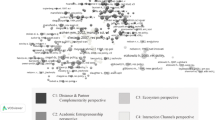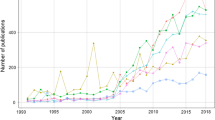Abstract
In this paper the role of Chinese universities in enterprise–university research collaboration is investigated. This study focuses on a special aspect of the collaboration—co-authored articles. The two cases are analyzed: (1) research collaboration between Baosteel Group Corporation and Chinese universities; (2) research collaboration between China Petroleum & Chemical Corporation and Chinese universities. The co-authorship data over the period 1998–2007 were searched from CNKI database, the largest Chinese publication and citation database. The main findings are as follows: the number of articles co-authored by enterprise and university scientists has been increasing rapidly; the share of co-authored articles has been growing; the authors from universities are more possible to be the first authors; as a whole, enterprise–university co-authored articles tend to receive more citations and get downloaded more frequently; a mathematical orientation emerges in the enterprise–university articles. To reveal and describe such a trend the methods of keywords analysis and co-occurrence analysis are applied. The Chinese government’s policy instruments and substantial supports for pushing and improving enterprise–university research collaboration are introduced and analyzed.





Similar content being viewed by others
References
Beaver, D., & Rosen, R. (1978a). Studies in scientific collaboration: Part 1. The professional origins of scientific co-authorship. Scientometrics, 1(1), 65–84.
Beaver, D., & Rosen, R. (1978b). Studies in scientific collaboration: Part 2. Scientific co-authorship, research productivity and visibility in the French scientific elite 1799–1830. Scientometrics, 1(2), 133–149.
Beaver, D., & Rosen, R. (1979). Studies in scientific collaboration: Part 3. Professionalization and the natural history of modern scientific co-authorship. Scientometrics, 1(3), 231–245.
Belkhodja, O., & Landry, R. (2007). The Triple-Helix collaboration: Why do researchers collaborate with industry and the government? What are the factors that influence the perceived barriers? Scientometrics, 70(2), 301–332.
Danell, R., & Persson, O. (2003). Regional R&D activities and interactions in the Swedish Triple Helix. Scientometrics, 58(2), 205–218.
D’Este, P., & Patel, P. (2007). University–industry linkages in the UK: What are the factors underlying the variety of interactions with industry? Research Policy, 36(9), 1295–1313.
Egghe, L. (1991). Theory of collaboration and collaborative measures. Information Processing & Management, 27(2–3), 177–202.
Etzkowitz, H., & Leydesdorff, L. (1995). The Triple Helix—University–industry–government relations: A laboratory for knowledge based economic development. EASST Review, 14, 14–19.
Etzkowitz, H., & Leydesdorff, L. (2000). The dynamics of innovation: From National Systems and “Mode 2” to a Triple Helix of university–industry–government relations. Research Policy, 29(2), 109–123.
Furukawa, T., Shirakawa, N., et al. (2011). Quantitative analysis of collaborative and mobility networks. Scientometrics, 87(3), 451–466.
Gibbons, M., Limoges, C., et al. (1994). The new production of knowledge: The dynamics of science and research in contemporary societies. London, UK: Sage.
Halilem, N., Amara, N., et al. (2011). Is the academic Ivory Tower becoming a managed structure? A nested analysis of the variance in activities of researchers from natural sciences and engineering in Canada. Scientometrics, 86(2), 431–448.
Havemann, F. & Katz, J. COLLNET and virtual collaboration. http://www.collnet.de/. Accessed 28 Sep 2010.
Katz, J. S., & Martin, B. R. (1997). What is research collaboration? Research Policy, 26, 1–18.
Kretschmer, H., Liang, L. M., & Kundra, R. (2001). Foundation of a global interdisciplinary research network (COLLNET) with Berlin as the virtual centre. Scientometrics, 52(3), 531–537.
Laudel, G. (2001). Collaboration, creativity and rewards: Why and how scientists collaborate. International Journal of Technology Management, 22(8), 762–781.
Leydesdorff, L. (2000). The triple helix: An evolutionary model of innovations. Research Policy, 29(2), 243–255.
Leydesdorff, L., Dolfsma, W., et al. (2006). Measuring the knowledge base of an economy in terms of triple-helix relations among ‘technology, organization, and territory’. Research Policy, 35(2), 181–199.
Leydesdorff, L., & Meyer, M. (2010). The decline of university patenting and the end of the Bayh-Dole effect. Scientometrics, 83(2), 355–362.
Leydesdorff, L., & Rafols, I. (2011). Local emergence and global diffusion of research technologies: An exploration of patterns of network formation. Journal of the American Society for Information Science and Technology, 62(5), 846–860.
Liang, L. M., Guo, Y. Z., & Davis, M. (2002). Collaborative patterns and age structures in Chinese publications. Scientometrics, 54(3), 473–489.
Liang, L. M., Kretschmer, H., Guo, Y. Z., & Beaver, D. (2001). Age structure of scientific collaboration in Chinese computer science. Scientometrics, 52(3), 471–486.
Liang, L. M., Liu, J. W., & Rousseau, R. (2004). Name order patterns of graduate candidates and supervisors in Chinese publications: A case study of three major Chinese universities. Scientometrics, 61(1), 3–18.
Liang, L. M., Zhang, L., Kretschmer, H., & Scharnhorst, A. (2006). Geographical and lingual preferences in scientific collaboration of the European Union (1994–2003). In Proceedings of international workshop on webometrics, informetrics and scientometrics & seventh COLLNET meeting, pp. 147–156, May 2006, Nancy, France.
Liang, L. M., & Zhu, L. (2002). Major factors affecting China’s inter-regional research collaboration: Regional scientific productivity and geographical proximity. Scientometrics, 55(2), 287–316.
Lundvall, B. Å. (1992). National Systems of Innovation. London: Pinter.
Nelson, R. R. (1993). National Innovation Systems: A comparative study. New York: Oxford University Press.
Rudy, A., & Ten Eyck, T. A. (2006). Institutional and/versus commercial media coverage: Representations of the University of California, Berkeley–Novartis agreement. Public Understanding of Science, 15(3), 343–358.
The Legal Information Center of Peking University (in Chinese). (2010). Retrieved October 10, 2010, from http://www.lawinfochina.com/.
The Ministry of Personnel. (2000). Announcement about approving 62 companies to establish post-doctoral research station (in Chinese). Retrieved October 10, 2010, from http://www.51labour.com/LawCenter/lawshow-30397.html.
The Ministry of Science and Technology. (2007). The first batch of four industrial technology innovation and strategic alliances, introduction (in Chinese). Retrieved October 10, 2010, from http://www.most.gov.cn/jscxgc/jscxdtxx/200706/t20070619_50541.htm.
The National Medium- and Long-Term Program for Science and Technology Development (in Chinese). (2010). Retrieved October 10, 2010, from http://www.gov.cn/jrzg/2006-02/09/content_183787.htm.
Wang, Y., Wu, Y. S., Pan, Y. T., Ma, Z., & Rousseau, R. (2005). Scientific collaboration in China as reflected in co-authorship. Scientometrics, 62(2), 183–198.
Yin, L. C., Kretschmer, H., Hanneman, R. A., et al. (2006). Connection and stratification in research collaboration: An analysis of the COLLNET network. Information Processing & Management, 42(6), 1599–1613.
Acknowledgments
The work presented in this paper is sponsored by the National Natural Science Foundation of China (Grant Number 70973118).
Author information
Authors and Affiliations
Corresponding author
Rights and permissions
About this article
Cite this article
Liang, L., Chen, L., Wu, Y. et al. The role of Chinese universities in enterprise–university research collaboration. Scientometrics 90, 253–269 (2012). https://doi.org/10.1007/s11192-011-0503-x
Received:
Published:
Issue Date:
DOI: https://doi.org/10.1007/s11192-011-0503-x




